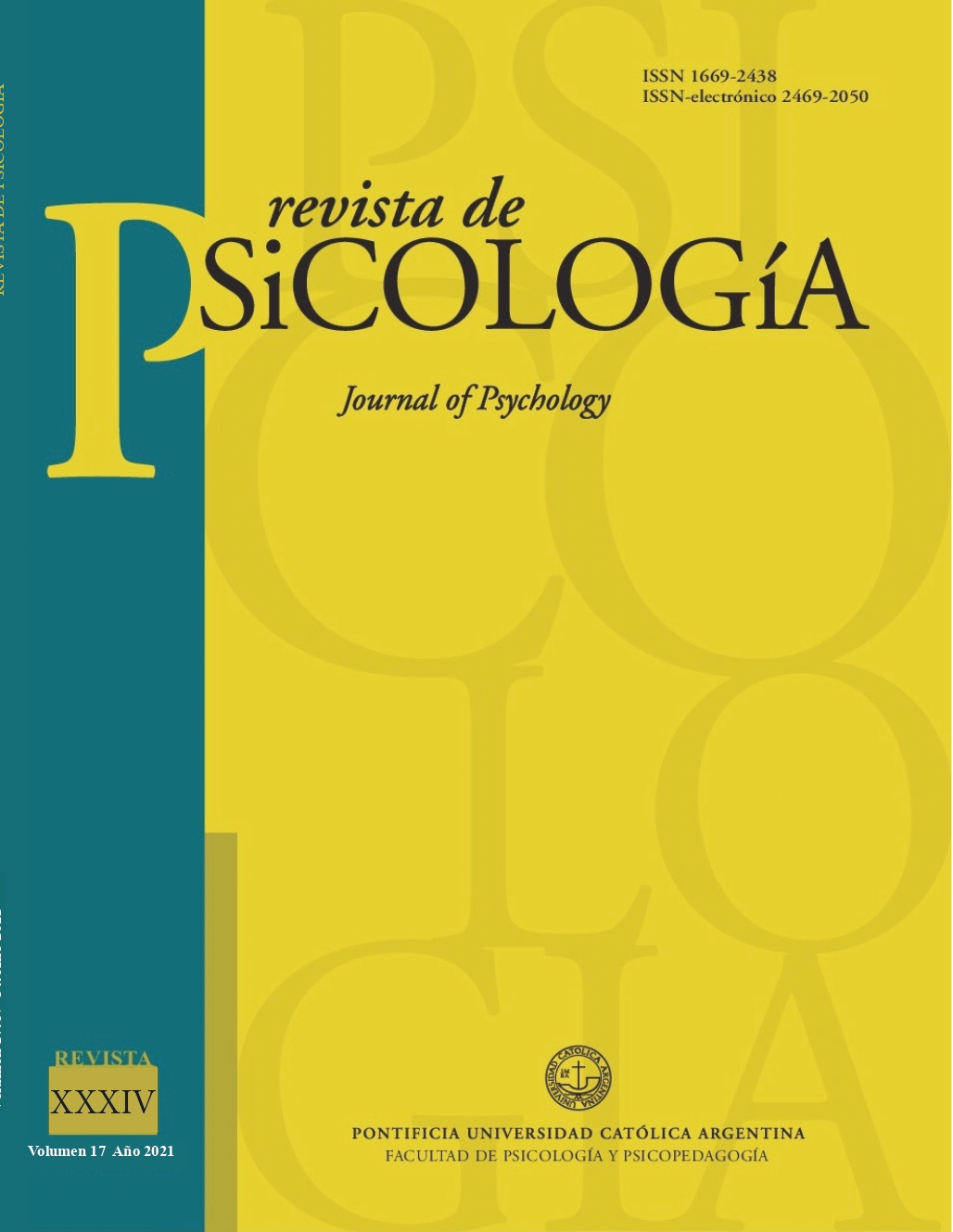Study of the Psychometric Properties of the Self-Compassion Scales (EAC) in a Sample of Mental Health Professionals in Argentina
DOI:
https://doi.org/10.46553/RPSI.17.34.2021.p21-34Keywords:
self-compassion, validation, psychometric propertiesAbstract
Introduction: The purpose of this research was to evaluate the psychometric properties of the Self-Compassion Scale (SCS) in a sample of mental health professionals in Argentina. Method: The sample used was non-probabilistic and voluntary of 252 psychologists and psychiatrists residing in CABA, Argentina. A non-experimental, cross-sectional, classical instrumental study was designed. Results: The confirmatory factor analysis performed allowed verification of the six-factor structure. In turn, the results reported negative and significant correlations between the dimensions theoretically considered as opposites. The internal consistency is adequate in all the subdimensions and in the total scale. Conclusion: The scale has adequate properties for its use in the population of CABA, Argentina.
Downloads
References
Acinas, M. P. (2012). Burn-out y desgaste por empatía en profesionales de cuidados paliativos. Revista digital de medicina psicosomática y psicoterapia, 2(4), 1-22.
Albertson, E., Neff, K., & Dill-Shackleford, K. (2014). Self-Compassion and Body Dissatisfaction in Women: A Randomized Controlled Trial of a Brief Meditation Intervention. Mindfulness, 6(3), 444-454. doi: 10.1007/s12671-014-0277-3
Araya, C., & Moncada, L. (2016). Auto-compasión: origen, concepto y evidencias preliminares. Revista Argentina de Clínica Psicológica, 25(1), 67-78. ISSN: 0327-6716
Araya, C., Moncada, L., Fauré, J., Mera, L., Musa, G., Cerda, J., ... & Brito, G. (2017). Adaptation and preliminary validation of the self-compassion scale in a chilean context. Latinoamerican Journal of Positive Psychology, 3, 47-58. ISSN: 0719-4420
Bollen, K., & Long, J. (1993). Testing structural equation models. Sage.
Brown, T. A. (2006). Confirmatory factor analysis for applied research. Guilford publications.
Browne, M. W., & Cudeck, R. (1993). Alternative ways of assessing model fit En: Bollen KA, Long JS, eds. Testing Structural Equation Models. Sage, 136-162.
Epskamp, S., Stuber, S., Nak, J., Veenman, M., & Jorgensen, T. D. (2019). semPlot: Path Diagrams and Visual Analysis of Various SEM Packages’ Output (Version 1.1. 2)[Computer software].
Fletcher, T. D., & Fletcher, M. T. D. (2013). Package psychometric. Recuperado de http://cran. rproject. org/web/packages/psychometric/psychometric. pdf Vol 4.
Freiberg Hoffmann, A., Stover, J. B., de la Iglesia, G., & Fernández Liporace, M. (2013). Polychoric and Tetrachoric Correlations in Exploratory and Confirmatory Factorial Studies. Ciencias Psicológicas, 7(2), 151-164. Recuperado de http://www.scielo.edu.uy/scielo.php?script=sci_arttext&pid=S1688-42212013000200005&lng=es&tlng=en
García-Campayo, J., Navarro-Gil, M., Montero-Marín, J., López-Artal, L. y Demarzo, M. (2014). Validation of the Spanish versions of the long (26 items) and short (12 items) forms of the Self-Compassion Scale (SCS) Health and Quality of Life Outcomes, 12, (4) 1-9.
Gilbert, P. (2009). The compassionate mind: A new approach to life’s challenges. Oakland, Calif: New Harbinger Publications.
Germer, C. (2011). El poder del "mindfulness": Libérate de los pensamientos y las emociones autodestructivas. Madrid: Paidos.
Germer, C. & Siegel, R. (2012). Wisdom and compassion in psychotherapy: deepening mindfulness in clinical practice. New York, USA: Guilford Press.
Hair, J. F., Black, W. C., Babin, B. J., Anderson, R. E., & Tatham, R. L. (2006). Multivariate Data Analysis. Pearson Prentice Hall.
Hu, L. T., Bentler, P. M., & Kano, Y. (1992). Can test statistics in covariance structure analysis be trusted?. Psychological bulletin, 112(2), 351. https://psycnet.apa.org/doi/10.1037/0033-2909.112.2.351
Hupfeld, J., y Ruffieux, N. (2011). Validierung einer deutschen Version der Self-Compassion Scale (SCS-D). Zeitschrift Für Klinische Psychologie Und Psychotherapie, 40(2), 115-123. https://doi.org/10.1026/1616-3443/a000088
Jorgensen, T. D., Pornprasertmanit, S., Schoemann, A. M., Rosseel, Y., Miller, P., Quick, C., & Garnier-Villarreal, M. (2018). semTools: Useful tools for structural equation modeling. R package version 0.5-1.
Kline, R. B. (2018). Response to leslie hayduk’s review of principles and practice of structural equation modeling. Canadian Studies in Population [ARCHIVES], 45(3-4), 188-95.
Kornfield, J. (2008). The wise heart: a guide to the universal teachings of Buddhist psychology. New York, USA: Bantam Books.
Mantzios, M., Wilson, J. & Giannou, K. (2013). Psychometric properties of the Greek versions of the self-compassion and mindful attention and awareness scales. Mindfulness, 2(3) 89-102. doi:10.1007/s12671-013-0237-3
Muthén, B., & Kaplan, D. (1985). A comparison of some methodologies for the factor analysis of non‐normal Likert variables. British Journal of Mathematical and Statistical Psychology, 38(2), 171-189. https://doi.org/10.1111/j.2044-8317.1985.tb00832.x
Neff, K. D. (2003a). Development and validation of a scale to measure self-compassion. Self and Identity, 2, 223-250. https://doi.org/10.1080/15298860309027
Neff, K. (2003b). Self-compassion: An alternative conceptualization of a healthy attitude toward oneself. Self and Identity, 2, 85-102.
Neff, K. D. (2012). The science of self-compassion. In C. K. Germer y R. D. Siegel (Eds.), Wisdom and compassion in psychotherapy: Deepening mindfulness in clinical practice (pp. 79-92). New York, NY, US: The Guilford Press.
Neff, K. D. (2016). The Self-Compassion Scale is a valid and theoretically coherent measure of self-compassion. Mindfulness, 7(1), 264-274. https://doi.org/10.1007/s12671-015-0479-3
Nunnally, J. C., & Bernstein, I. H. (1994). Psychometric theory (3rd ed.). McGraw Hill.
Pastorelli Rhor, J., & Gargurevich, R. (2018). Propiedades psicométrica de la escala de autocompasión en estudiantes de medicina de Lima. Revista Interamericana de Psicología, 52(2). pp. 246-261. https://www.researchgate.net/profile/Rafael-Gargurevich/publication/330193124_Propiedades_psicometricas_de_la_escala_de_autocompasion_en_estudiantes_de_medicina_de_lima/links/5c599056a6fdccb608a97977/Propiedades-psicometricas-de-la-escala-de-autocompasion-en-estudiantes-de-medicina-de-lima.pdf
Revelle, W. (2018). Psych: Procedures for personality and psychological research (Version 1.9. 12.31)[Computer software]. Northwestern University.
Raes F, Pommier E., Neff, K.D., Van Gucht, D. (2011). Construcción y validación factorial de una forma corta de la escala de autocompasión. Clin Psychol Psychother 2011, 18: 250-255. 10.1002 / cpp.702. doi.org/10.1002/cpp.702
Rosseel, Y. (2017). Lavaan: An R package for structural equation modeling and more. Version 0.5–12 (BETA). Journal of statistical software, 48(2), 1-36.
Schumacker, R., & Lomax, R. (2016). A beginner´s guide to structural equation modeling. Routledge.
Shapiro, S., Brown, K., & Biegel, G. (2007). Teaching self-care to caregivers: Effects of mindfulness-based stress reduction on the mental health of therapists in training. Training and Education in Professional Psychology, 1(2), 105-115. doi: 10.1037/1931-3918.1.2.105
Villanueva, R. A. M., & Chen, Z. J. (2019). ggplot2: Elegant graphics for data analysis. Springer.
Woo Kyeong, L. (2013). Self-compassion as a moderator of the relationship between academic burn-out and psychological health in Korean cyber university students. Personality and Individual Differences, 54(8), 899-902. doi: 10.1016/j.paid.2013.01.001.
Downloads
Published
How to Cite
Issue
Section
License



















